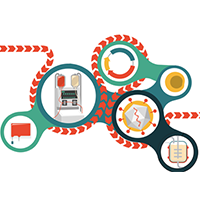The Evolution of Product Transfer and Labeling in Cellular Therapy
Cell Gene Therapy Insights 2018; 4(3), 51-57.
10.18609/cgti.2018.007
What are your roles and responsibilities at UCSF and what is your overall experience in cellular therapy?
I am the Senior Supervisor of the Blood and Marrow Transplant (BMT) Laboratory at UCSF. Our laboratory provides support for many different kinds of cellular therapies, but our main service is to support clinical bone marrow transplants for allogeneic and autologous patients. We have also been focused on processing immune cells for CAR-T immunotherapy, a trend seen nationwide in many other labs. My core responsibility in the lab is to manage the quality of cellular processing and storage. In addition, I manage operational issues that may occur with our cellular products. It is my responsibility to confirm that we are following up to date regulations and have the proper accreditations to stay in compliance.
I have been managing UCSF’s BMT Laboratory for 6 years. Prior to UCSF, I held the same position of Senior Supervisor at Florida Hospital Orlando, where I helped to establish a new cellular therapy laboratory starting in 1996.
Your laboratory adheres to the International Society of Blood Transfusion (ISBT) 128 consensus standards for the identification and traceability of cellular therapy products. How do these guidelines benefit patients and laboratories worldwide?
Having been in the field for over 20 years, I have firsthand experience of the evolution of product transfer and labeling in cellular therapy laboratories. We started to receive products labeled in the same way. We still receive products that are not labeled using ISBT 128 because they haven’t implemented the system or the products were labeled prior to ISBT 128 regulations. I will say that most of the products coming through our doors do have ISBT labels.
When the ISBT 128 guidelines for the information transfer of cellular products, which included label standardization, began, it was a bit overwhelming for the laboratory. The guidelines affected our standard operating procedures (SOPs), validation standards and personnel training. However, even though the new standards felt like a major overhaul in procedures, when we started implementing the process, we realized that it was not as cumbersome as we had initially thought. After the standards were applied to laboratories worldwide, we were sure to receive products labeled in the same way that we labeled our own products. This made it much easier for us to work with products from other laboratories which always included all of the necessary identification information. I am now very thankful to have the guidelines.
The American Association of Blood Banks (AABB) and other organizations are requiring all facilities to use the ISBT128 labeling by July 1, 2018. What would a laboratory need to do to be compliant? Are there any special systems or software you would recommend?
Currently, the majority of accreditation programs already require that ISBT 128 wording and coding for product identification be used. However, it is not yet a requirement that a labeling system with a readable barcode be used, or that all ISBT 128 standards are adhered to. Next year the accreditation programs will require a strict adherence to ISBT 128.
For a lab to become compliant, an implementation plan should first be constructed. Developing an implementation plan may sound overwhelming to some labs, but overall it is not at all difficult. The plan should consider what types of products are generated, sent and received, and include the relevant ISBT 128 codes for each product. The International Council for Commonality in Blood Banking Automation (ICCBBA) has an amazing, easy to use website dedicated to ISBT 128 standards. The site has everything from the basics to lookup tools for easy searching of product codes. In some cases, with rare products or unusual storage conditions, there may not be an existing code. Fortunately, the ICCBBA is very responsive to email and can quickly create a code for any special circumstance which makes compliance easy.
The implementation plan also needs to include a labeling system. Our lab decided to use the Digi-Trax HemaTrax-CT system because the company is well established in supporting cellular product compliance having started with whole blood products many years ago. They created specialized software for cellular therapy labs, which is slightly different from the software they have for whole blood processing due to the varied requirements in cellular product labeling. The great thing about the HemaTrax-CT software is that it’s extremely user-friendly and inexpensive. It’s common to think that new software is going to cost upwards of six figures, but this program is very inexpensive and only requires a simple installation to start using it. Another great thing about Digi-Trax is their excellent customer service. At the beginning of using the system I had a lot of questions and they responded to me within 24 hours. They’re also very flexible and willing to change their software to accommodate ISBT 128 standards. Overall, I’m very happy with the company.
What training was required when implementing your lab’s plan for ISBT 128 compliance?
Our lab started writing an ISBT128 compliance plan in May of 2012 and had already started implementing it by September of the same year. One of the most time consuming tasks when creating the plan was looking up codes for our products. At the time, we had one staff member dedicated to finding codes who spent quite a few hours a week on the project. When it came to installing the labeling software, we enlisted the help of our IT division at UCSF who made sure that the software was compliant with institution firewalls. After installation, we then needed to create a validation plan to make sure that labels printed with the required information. The plan included printing out many labels and manually checking for correctness.
Once the labeling system was installed and validated, we started to train the laboratory staff. Training was one-on-one and included practice runs. The staff were given possible scenarios where labels would need to be printed to ensure thorough training. Four or five different scenarios with varied products and temperatures requiring different labels were given to staff to practice creating and printing labels. Staff were considered trained when the practice runs were within compliance.
Following the initial training, staying within compliance still felt new, so we created a checklist. Staff would follow the checklist when printing a label to be sure to include all of the different pieces of information required by accreditation programs and the FDA. Within 1 or 2 months, the staff loved the new labeling system and were surprised at how easy the HemaTrax-CT software was to use.
How did your lab label cellular products before moving to the on-demand labeling system?
Our previous labels were purchased from a print shop. They were 4 in. x 4 in. cardstock with blank spaces under headings, such as patient name, date of collection and total volume. The blanks were filled out by staff in their own handwriting, which was sometimes illegible. It created an enormous problem when labels couldn’t be read. Labels could also be ruined when spraying the product with alcohol causing the ink to run or be wiped away.
Another problem we ran into with our previous labeling system was that there was additional information required to be noted directly onto the bag. Our cardstock labels were not stickers, and instead attached with little plastic tags. Therefore, staff would have to write some information onto the bags and in addition, attach the cardstock overtag. Much of the information written on the labels was unnecessary and was included out of tradition and not necessity. Transitioning to this new way of standardized labeling makes everything easier. The standards are very clear, we don’t use handwriting anymore, and we only include information required by the accreditation programs. Overall it was really easy to switch from our old way of labeling to the current method.
One of the great time savers when using the new system is the ability to save information within the software and reprint labels. Instead of writing the same information, over and over, by hand, the system can print multiple labels with the same information. Cryogenic vials, for example, have a very small label and we used to write with a cryo-pen in tiny writing on each vial’s label. With the new system, we’ve stopped writing and rewriting information. It has saved us a lot of time.
How are the ISBT128 guidelines updated to accommodate new therapies or technologies?
Adding new therapies to the guidelines is a process that is still being worked out. An example of a new therapy needing to be included is CAR-T cells for immunotherapy. 4 years ago I started working with cells for CAR-T immunotherapy clinical studies. Initially, the labeling requirements for cells going into manufacturing facilities were ridiculous with multiple labels for each bag. There was a lot of unnecessary information added onto labels but they were initially lacking some standard information also. When we would tell a manufacturing facility that there was additional important information that needed to be included, they would just add another label instead of rethinking the labeling strategy.
Now, companies that have gone through CAR-T clinical trials are more up to speed with ISBT 128 guidelines. Their new labeling requirements are very similar to the existing ISBT 128 standards. Companies are becoming more and more aware that we require standardized labeling from them, which is very important when our accreditation programs require compliance from us. Fortunately, the joining of company labeling standards with accredited laboratory standards is getting easier. We have spoken with the FDA to get their perspective as well. All sides are communicating well and solutions coming to light.
Do you anticipate new, updated guidelines on labelling and coding for CAR-T cells in the future?
Yes, I believe the accreditation programs are working on updating their guidelines for CAR-T cells. However, the guidelines will need to be very general because most uses for CAR-T cells are in clinical trials, and each trial has varied conditions and labeling requirements. Additionally, companies producing CAR-T therapies are not required to be accredited, so it is not mandatory for them to use standardized coding and labeling. I think that the FDA will need to mandate labeling guidelines for companies to comply. However, the FDA understands that no two therapies are the same, and would prefer to be flexible and prescriptive. There is not yet a clear solution, but seeing as CAR-T therapies will likely become a standard of care, we will need to work together to satisfy everyone’s needs.
Affiliation
Lizette Caballero
MLS (ASCP)CM, Senior Supervisor, UCSF BMT Laboratory, USA.
This work is licensed under a Creative Commons Attribution- NonCommercial – NoDerivatives 4.0 International License.


